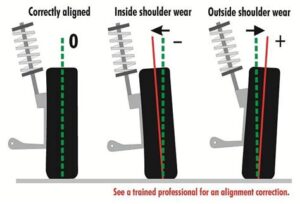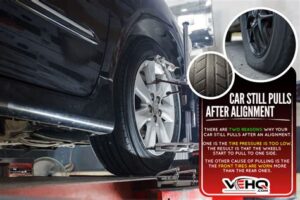Is your vehicle pulling to one side, or do you notice uneven tire wear? Misalignment can be a common yet often overlooked issue that affects both driving safety and vehicle performance. In this article, we will explore the ins and outs of fixing car alignment, starting with the basics of what alignment is and how to identify signs of misalignment. You will learn about the essential tools you’ll need for the job and follow a straightforward step-by-step guide to rectify the issue effectively. Additionally, we will highlight common mistakes to avoid during the process and the significant benefits of proper alignment to enhance your car’s performance. By the end of this guide, you’ll be equipped with the knowledge to get your vehicle back on track, ensuring a safer and smoother ride.
Understanding Wheel Alignment Basics: How To Identify Misalignment
Identifying misalignment is crucial for ensuring that your vehicle drives smoothly and efficiently. Misalignment can lead to uneven tire wear, poor handling, and decreased fuel efficiency. Here are key indicators to look for:
- Uneven Tire Wear: Check the tread on your tires. If the wear is more pronounced on one side, it may indicate misalignment.
- Vehicle Pulling: If your car pulls to one side while driving, this is a classic sign of alignment issues.
- Steering Wheel Off-Center: When driving straight, if your steering wheel isn’t centered, it points to misalignment.
- Vibration in the Steering Wheel: Excessive vibrations could be a sign of improper alignment or other issues with your vehicle.
- Recalls Implemented: It’s worth checking if there are any recalls for your car model related to wheel alignment that might affect your vehicle.
To confirm your observations, consider using the following methods:
| Method | Description |
|---|---|
| Visual Inspection | Look at the angles of your wheels when parked. They should be perpendicular to the ground. |
| Test Drive | Take your vehicle for a short drive and pay attention to pulling or handling issues. |
| Professional Assessment | If in doubt, take your car to a trusted mechanic for a detailed alignment check. |
By being aware of these signs and how to correctly analyze them, you’ll be well-equipped to address any wheel alignment issues effectively and keep your vehicle performing at its best.
Essential Tools Needed: How To Prepare For Alignment Adjustment
To successfully learn how to fix the alignment on a car, having the right tools is essential. Using the appropriate equipment not only makes the process smoother but also ensures accurate adjustments. Here’s a list of tools you will need to prepare for alignment adjustment:
| Tool | Description |
|---|---|
| Alignment Rack | A specialized platform that allows for precise measurements of wheel angles. |
| Toe Plates | Used to measure the toe angle, helping to align the wheels accurately. |
| Camber Gauge | A tool for measuring the camber angle, ensuring the wheels are set at the correct angle to the road. |
| Wrench Set | Includes various sizes for adjusting bolts and nuts in the suspension system. |
| Jack and Jack Stands | To lift the vehicle safely and securely during the adjustment process. |
| Measurement Tape | For measuring wheel distances and ensuring proper alignment specifications. |
| Level | To ensure that the vehicle is flat before making adjustments. |
Before beginning your alignment adjustment, make sure all these tools are in good condition and easily accessible. Proper preparation with the right tools will enable you to efficiently adjust the alignment and enhance your vehicle’s performance.
Step-By-Step Guide: How To Fix The Alignment On A Car
Aligning your car properly is essential for optimal performance and tire longevity. Here’s a detailed how to guide for fixing the alignment on your car.
- Check Tire Pressure: Start by ensuring all tires are inflated to the recommended pressure. Uneven tire pressure can affect alignment.
- Inspect Tires and Suspension: Look for any visible wear on the tires and check the suspension components, such as ball joints and tie rods, for damage or wear.
- Perform a Preliminary Alignment Check: Use alignment tools or take your car to a mechanic for a preliminary check. This will help determine if an alignment is necessary.
-
Adjust Toe Settings:
Using your alignment machine or laser tool, adjust the toe settings. The toe refers to the direction the tires point relative to the centerline of the vehicle. It is essential for maintaining straight tracking.
-
Adjust Camber Settings:
The camber angle determines how much the wheels tilt inwards or outwards when viewed from the front. Adjust this angle to align it with specifications.
-
Adjust Caster Settings:
Caster angle influences steering and stability. Adjust the caster angle according to the manufacturer specifications.
- Test Drive: After making adjustments, take your car for a test drive to see how it handles. Pay attention to any pulling to one side or unusual vibrations.
- Get Professional Confirmation: If you’re uncertain about the alignment, consider taking your vehicle to a professional shop for a complete alignment check.
Following these steps will guide you on how to fix the alignment on your car correctly. Regular checks and maintenance ensure a smoother ride and prolongs the life of your tires.
Common Mistakes To Avoid: How To Ensure Proper Alignment
When it comes to how to fix the alignment on a car, avoiding common mistakes can make a significant difference in achieving optimal results. Here are some pitfalls to watch out for:
- Neglecting Tire Condition: Before making alignment adjustments, it’s crucial to ensure that tires are in good condition. Worn or unevenly inflated tires can lead to further misalignment.
- Ignoring Suspension Issues: Misalignment can often be a symptom of deeper suspension problems. Always check the suspension components for damage or wear before performing an alignment.
- Using Inaccurate Tools: Using miscalibrated or incorrect tools can lead to improper adjustments. Always ensure that your tools are suitable for the job and are functioning correctly.
- Skipping the Test Drive: After fixing the alignment, it’s essential to take the car for a test drive. This helps to identify any lingering issues that may need further adjustment.
- Not Consulting a Professional: If you’re unsure about how to proceed, don’t hesitate to consult a professional mechanic. Their expertise can save you time and potential complications down the road.
Avoiding these common mistakes will help you ensure that your car’s alignment is set correctly, improving performance and reducing tire wear in the process.
Benefits of Proper Alignment: How To Improve Car Performance
Ensuring that your vehicle’s wheels are properly aligned is crucial for maintaining optimal performance. Here are some key benefits of proper alignment and how it can significantly enhance your car’s performance:
- Improved Fuel Efficiency: When your wheels are aligned correctly, your vehicle experiences less rolling resistance. This means the engine doesn’t have to work as hard to move the car, leading to better gas mileage and lower fuel costs.
- Enhanced Tire Lifespan: Proper alignment helps distribute wear evenly across all tires. This can extend the life of your tires, saving you money on replacements and ensuring better handling overall.
- Smoother Drive: When all four wheels are aligned appropriately, you’ll enjoy a smoother and more stable ride. This not only contributes to passenger comfort but also improves handling, especially during turns and sudden maneuvers.
- Increased Safety: Misaligned wheels can lead to unstable handling and unpredictable braking responses. By maintaining proper alignment, you enhance your car’s safety, reducing the risk of accidents resulting from handling issues.
- Better Handling: A vehicle with correctly aligned wheels responds better to steering inputs, providing improved control. This is essential for both everyday driving and performance-oriented situations.
Understanding how to maintain proper wheel alignment is vital for improving your car’s overall performance and longevity. Regular checks and adjustments can not only enhance your driving experience but also contribute to cost savings over time.
Frequently Asked Questions
What is car alignment and why is it important?
Car alignment refers to the adjustment of the vehicle’s suspension system. Proper alignment ensures that your wheels are parallel to each other and perpendicular to the ground, which helps improve handling, extends tire life, and enhances safety.
What are the signs that my car is out of alignment?
Signs of misalignment include uneven tire wear, the vehicle pulling to one side, a crooked steering wheel when driving straight, and vibrations in the steering wheel.
How often should I check my car’s alignment?
It’s advisable to check your car’s alignment at least once a year or whenever you notice signs of misalignment. Additional checks may be necessary after hitting a pothole or in case of any suspension repairs.
What tools do I need to fix the alignment on my car?
To align your car wheels, you’ll need a level, a tape measure, wrenches, and a camber gauge. Professional alignment typically requires specialized equipment, so visiting a mechanic or alignment shop is often recommended.
Can I fix my car’s alignment myself?
While minor adjustments can be made at home using basic tools, achieving precise alignment usually requires professional equipment and expertise. It’s recommended to consult a professional for accurate alignment services.
What are the steps to manually check wheel alignment?
To manually check wheel alignment, ensure the car is on a flat surface, measure the distance between the front and rear of the front tires to check toe angle, and use a camber gauge to check the tilt of the tires.
What can I do to prevent alignment issues in the future?
To prevent alignment issues, regularly inspect and maintain your tires, avoid potholes and road debris, check your suspension components, and have your alignment checked during routine maintenance.





